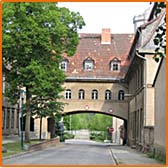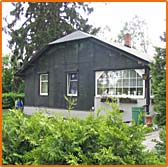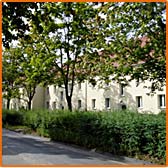The Messingwerksiedlung is a historico-cultural highlight of the
Finow Valley, dating back to early industrialization. Within 300
years, a complex ensemble of settlements emerged around the brass
company, which has been established in its present location between
1721 and 1725. This ensemble impressively demonstrates how the combination
of living and working was once envisioned.
Dating back to the 1720s,
the two preserved houses near the Obertor (upper gate) are probably
the oldest workers’ residences in
the Federal State of Brandenburg. The representative Hüttenamt
(iron works office) also has been constructed about three centuries
ago. With regard to town planning, the settlement’s contemporary
shape results from concepts developed by the Berlin architects Paul
Mebes and Paul Emmerich between 1913 and 1929. Within the same period
of time also Villa Hirsch (Hirsch Mansion), the Torbogenhaus (Archway
House) and the worker’s houses on Gustav-Hirsch-Platz (Gustav
Hirsch Square) were constructed; the latter being reminiscent of
the Holländisches Viertel (Dutch Quarter) in Potsdam. A little
later, in 1931/32, the Copper Houses by Krafft and Gropius were built.
In
1999 revitalization of the quarter started with maintaining the long
neglected buildings. The owner WHG (a communal housing association)
took up the concept by Mebes and Emmerich and reproduced the original
look of the listed houses on Gustav-Hirsch-Platz by means of dismantling
and maintenance. The aim of the project was to visibly retain the
architects’ central concern: combining modesty and practicality
with elegance. In order to settle the claim for sustainable building,
the old building substance was reused and modernized whenever possible.
Also worth mentioning is the fact that the wishes of the residents,
whose tie to their neighbourhood is uncommonly strong, were particularly
taken into consideration. The quarter’s revitalization is not
finished yet, but during recent years substantial progress has been
made. For example, the periphery of the actual works premises is
being decisively gentrified by clearing out, the creation of green
spaces and the opening of the Messingwerksiedlung towards the Finow
Canal. Another four buildings, namely the Hüttenamt, the Torbogenhaus
and two former civil servants’ houses, will be restored by
2009. By means of an extensive reshaping of the houses’ surroundings,
the housing estate will be opened towards the water of the Finow
Canal. Thus another 55 attractive, affordable and partly handicapped
accessible residences for individual wishes will be constructed in
a neighborhood of historical interest along the Finow Canal within
the next few years.
|


